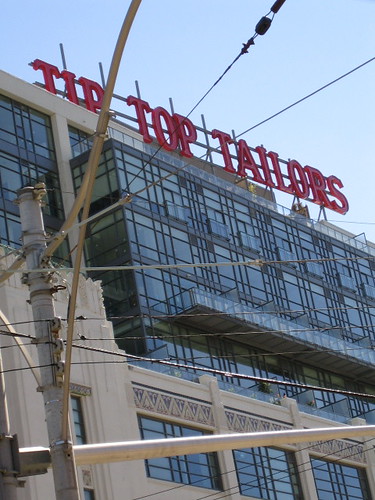First blog in months - quite a bit has changed. I'll spare you the details, but I've moved back to Canada, I'm living in Toronto, and I've taken a new role at a Waterloo-based mobile handset and services company. I'm just getting settled and so haven't had a lot of time to think about blogging, but I do have an hour and 15 minute commute both ways everyday to pontificate on the world's events.
Branding's Migration from Product Quality Expectations to Personal "Quality" Persona
Everyday during my commute, I pass a factory-turned-luxury loft called "Tip Top Lofts". Bear with me here, but this is an interesting example of the commercialization of personal space. Why would people pay a million dollars for a condo to be branded 'Tip Top Tailors'? Home-owners don't do this, so why is this ok for high-end condo owners?

Having grown up near Buffalo, NY, home-owners actually do "brand" their homes; the classic Buffalo-area example, is the xmas-time
Buffalo Bills animated lawn ornament.
If one considers the historical purpose of the brand, it was to consistently represent a product or company, thereby imparting a certain consistent consumer expectation for the quality of a product. For example, you had an expectation, before buying Quaker Oats, of the quality of Quaker Oaks based on past purchases of that brand. The Buffalo Bills example is a departure from this it seems to indicate something in the evolution of brand use from the perspective of the consumer:
Branding is no longer used solely by companies to reflect the quality of a product for MY consumption, it's used by ME to reflect MY "quality" to others.
Put another way, brands have been co-opted by consumers to reflect the persona they wish others to see in them. What I'm saying here isn't new: the hip-hoppers with their baggy
Fubu pants certainly know a skater when they see someone wearing
Dickie's pants.
An Aside: Social ProofNot to get too academic, but the concept of "personal branding" seems to make sense in a society with information overload. Human beings are naturally programmed to generalize the environment around us to facilitate processing of information.
I've
mentioned social proof previously, but for review, according to
wikipedia, social proof is:
"...a psychological phenomenon that occurs in ambiguous social situations when people are unable to determine the appropriate mode of behavior. Making the assumption that surrounding people possess more knowledge about the situation, they will deem the behavior of others as appropriate or better informed."
In other words,
We're using the brands we wear to fast-track the decision-making process other's use to judge us.
The Cellphone as a "Personal Device" is Exactly Wrong
I hear it often that the mobile phone is the most personal of consumer electronics - it seems rationale but consider this:
- The mobile phone is probably the most public piece of consumer electronics we own - we have it with us, and use it in front of everyone, all the time.
- The #1 way people "share" camera phone pictures is by physically showing people the pictures on their phone.
Do we think that "personalization features" such as ring tones and wallpapers are for the owner of the device because they get some intrinsic maternal-like satisfaction from customizing their phone?
Personalization features are the tools people use to extend the brand of "self".
The iPhone is a "Me Brand"As technologists, we look at the incredible success Apple has had in gaining mind share of the iPhone and we jump straight to features: touch screen, big screen, multimedia, gigabytes, apple store. The iPhone, however, isn't particularly impressive technologically - most smart phones compare from a retail collateral "checkbox" perspective.
I suspect that Apple has transcended the technology argument by making the iPhone a fashion accessory to accompany Fubu or Dickie's demin. It's a beautifully aesthetically designed, well-positioned and marketed, device that allows it's trendy owners to fast-track the decision-making process other's use to judge them.
Will other handset vendors follow Apple with features, follow Apple's "brand", or embrace a differentiated "handset as a brand" strategy? The smart phone market, with it's still low penetration, can certainly accommodate other personas. My question: is Nokia Fubu or Dickie's?








